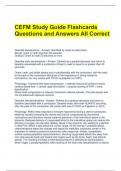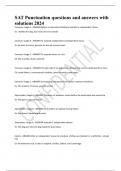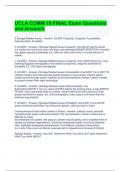CEFM Study Guide Flashcards
Questions and Answers All Correct
Describe decelerations - Answer- Identified by onset to nadir either:
Abrupt: onset to nadir less than 30 seconds
Gradual: Onset to nadir 30 seconds or more
Describe early decelerations - Answer- Defined as a gradual decrease and return to
baseline associated with a contraction (Onset to nadir is equal to or greater than 30
seconds)
Onset, nadir, and offset always occur coincidentally with the contraction, with the nadir
at the peak of the contraction (Because of the importance in timing related to
contractions, be very careful with TOCO vs palpation vs IUPC)
Physiology: Transient fetal head compression -> altered intracranial pressure and/or
cerebral blood flow -> central vagal stimulation -> gradual slowing of FHR -> early
deceleration
When head compression is relieved, autonomic reflexes subside. Clinically benign and
not correlated with adverse outcome
Describe late decelerations - Answer- Defined as a gradual decrease and return to
baseline associated with a contraction. Delayed onset, with nadir ALWAYS occurring
after the peak of the contraction. Be careful with use of TOCO vs Palpation or IUPC.
Physiology: Reflex fetal response to transient hypoxemia during a uterine contraction.
Maternal vessels traversing the uterine wall can be compressed by myometrial
contractions and therefore reduce maternal perfusion of the intervillous space of the
placenta. Reduced delivery of oxygenated blood to the intervillous space can reduce the
diffusion of oxygen into the fetal capillary blood in the chorionic villi, leading to a decline
in fetal PO2. When it falls below the normal range (15-25 mmHg in umbilical artery),
chemoreceptors detect the change and signal the medullary vasomotor center in the
brainstem to initiate a protective autonomic reflex response. Initially, sympathetic
outflow causes peripheral vasoconstriction, shunting oxygenated blood flow away from
non-vital vascular beds and toward vital organs such as the brain, heart, and adrenal
glands. The resulting increase in fetal blood pressure is detected by baroreceptors,
which trigger a parasympathetic reflex slowing of the heart rate (deceleration) to reduce
,cardiac output an return the blood pressure to normal. After the contraction, fetal
oxygenation is restored, autonomic reflexes subside, and the FHR gradually returns to
baseline. Rarely, fetal oxygenation can be interrupted sufficiently to result in metabolic
acidemia. In that event, a late decelration may result from direct hypoxic myocardial
depression. Since the latter mechanism requires metabolic acidemia, it can be excluded
by the observation of moderate variability or accelerations. Late decelerations
classically have been attributed to "uteroplacental insufficiency". However, this term can
Describe variable decelerations - Answer- Defined as an abrupt decrease in FHR below
the baseline of _> 15 pm lasting _> 15 seconds but <2 minutes (LESS than 15 seconds
to nadir). May or may not be associated with uterine contractions. When associated with
uterine contractions, they may vary in onset, depth, and duration from contraction to
contraction. A variable deceleration represents a fetal autonomic reflex response to
transient mechanical compression of the umbilical cord. Initially, compression of the
umbilical cord occludes the thin-walled, compliant umbilical vein, decreasing fetal
venous return and triggering a barorceptor-mediated reflex rise in FHR (sometimes
described as a shoulder). Further compression occludes the umbilical arteries, causing
an abrupt increase in fetal peripheral resistance and blood pressure. Baroreceptors
detect the abrupt rise in blood pressure and signal the medullary vasomotor center in
the brainstem, which in turn triggers an increase in parasympathetic outflow and an
abrupt decrease in heart rate. As the cord is decompressed, this sequence of events
occurs in reverse.
It is important to remember that umbilical cord compression can coincide with
interruption at any or all of the other points along the oxygen pathway. The observation
of a variable deceleration does not preclude interruption of fetal oxygenation at the level
of the maternal lungs, heart, vasculature, uterus or placenta. Therefore, for the
purposes of standardized FHR interpretation, a variable deceleration reflects
interruption of oxygen transfer from the environment to the fetus at one or more points
along the oxygen pathway.
Physiology Basics: Umbilical vein compresses first due to thin wall. Fetal hypertension
and drop in cardiac output stimulates the sympathetic nervous system. Umbilical artery
becomes occluded and then there is no blood flow from fetu
Describe prolonged deceleration - Answer- Defiined as a decrease of _> 15 bpm from
baseline that has a duration of _> 2 minutes but < 10 minutes. Onset may be gradual or
abrupt. Duration of > 10 minutes is considered a change in baseline. If the physiologic
mechanisms responsible for late or variable decelerations persist, a deceleration can
last long enough to be defined as a prolonged deceleration. A prolonged deceleration
reflects interruption of oxygen transfer from the environment to the fetus at one or more
points along the oxygen pathway.
For example, at the level of the maternal lungs, a prolonged deceleration can result
from maternal apnea during a convulsion. At the level of the maternal heart, a cardiac
arrhythmia can compromise cardiac output and cause a prolonged FHR deceleration. At
, the level of the vasculature, the oxygen pathway can be interrupted by maternal
hypotension associated with regional anesthesia or compression of the vena cava by
the gravid uterus.
Examples of interruption of the oxygen pathway at the level of the uterus include
excessive uterine activity or uterine rupture.
Examples at the level of the placenta include abruption or bleeding placenta previa.
Finally, at the level of the umbilical cord, examples include cord compression or
prolapse
How was FHR previously classified? - Answer- Reassuring vs non-reassuring
Lack of specifically recognized criteria for each term and absence of a third word to
describe many EFM tracings occurring in labor that were neither. These terms have
been abandoned in favor of a three-tiered category system. Reassuring is an adjective
meaning "restoring confidence and relieving anxiety". Problematic- do not use these
terms anymore!
Describe the "Three-tier" fetal heart rate classification system - Answer- Category I:
"Normal" Requires: Baseline rate 110-160 bpm, Moderate variability, no late, variable or
prolonged decelerations- only earlies
Category II- "Indeterminate" Everything else
Category III- "Abnormal" Requires one of these 4 patterns: (1) Absent variability with
recurrent late decelerations (2) absent variability with recurrent variable decelerations
(3) absent variability with bradycardia for at least 10 minutes (4) sinusoidal pattern for at
least 20 minutes
Describe the fetal oxygenation pathway from environment to fetus - Answer- Lungs ->
Heart -> Vasculature -> Uterus -> Placenta -> Umbilical Cord
Interruption of the oxygen pathway by compression of the umbilical cord can result in a
variable deceleration. Interruption of the oxygen pathway at the level of the tuerus or
placenta can result in a late decel. Interruption of the oxygen pathway at any point can
result in a prolonged decel. All clinically significant FHR decelerations (late, variable,
prolonged) have exactly the same trigger...
Interruption of oxygen transfer from the environment to the fetus at one or more points
along the oxygen pathway. So PRINCIPLE #1: Variable, late, or prolonged
decelerations signal interruption of the oxygen pathway at one or more points
Describe the fetal oxygenation pathway from fetus to potential injury - Answer-
Hypoxemia -> Hypoxia -> Metabolic acidosis -> Metabolic acidemia
Hypoxemia: low oxygen in blood
Hypoxia: Low oxygen in tissues- cannot be measured
Metabolic acidosis: Lactic acid in peripheral tissues
Metabolic acidemia: lactic acid in blood








